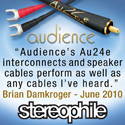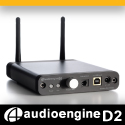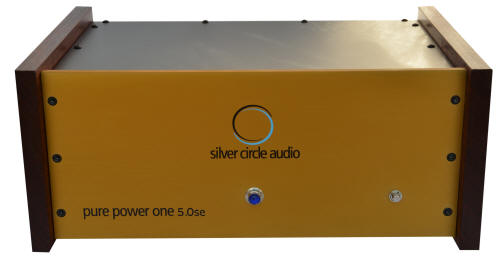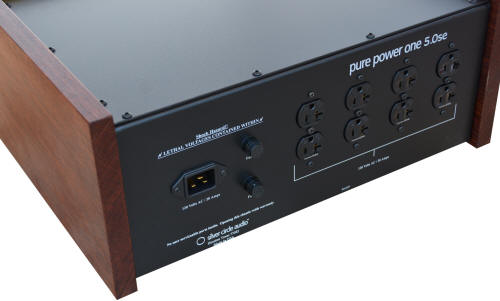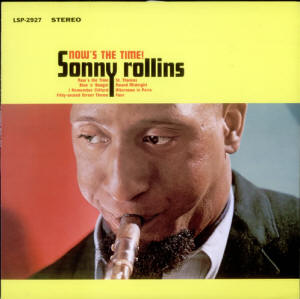|
|
You are reading the older HTML site
Positive Feedback ISSUE 63
silver circle audio Pure Power One 5se Power Line Conditioner - Sucking Up Those AC Line Nasties! as reviewed by Myles B. Astor
I find myself of two minds when it comes to the topic of AC power line conditioners (PLC). On the one hand, there's little question that—depending to some extent upon where you reside and lie on your power distribution grid—AC line quality greatly impacts the sound of our audio systems. Piggybacked atop that 120 V/60 Hz sine wave is a whole host of issues including but not limited to EMI, RFI, reflections of the 60 Hz wave, switching signals, noise (expressed as common [CMNR] and transverse mode noise rejection [TMNR]) and power factor. Truth be told, audiophiles living in major urban centers really have little idea of what your power company is supplying. And it's clear that despite the best efforts of electronics manufacturers to reduce their component's susceptibility to electrical line issues, there's still more work to do. On the other hand, the cure is often worse than the disease. Many PLCs collapse the soundstage (especially when it comes to the vertical dimension), throttle dynamics, smooth out the sound too much and/or roll off the upper octaves. Take for example my now admittedly long in the tooth, Tice Power Block/Titan combination. At the time of my mid ‘90s Sounds Like… magazine review, there was absolutely no question the Tice combo improved the low frequencies, decreased noise levels and improved imaging and soundstaging of my then conrad-johnson equipment. Then out of curiosity some ten years later (don't you ever get a hankering to fire up that older SOTA component languishing in the closet and listen to it again?), I took the Tice combo out of mothballs and re-commissioned them. Sadly, the unit didn't sound at all like how I remembered and its colorations were unmistakable. Were those issues there with the Tice way back when? Certainly, but the combination of our systems becoming more revealing and neutral coupled with electronics designers becoming more savvy to power line issues and designing better power supplies, made the Tice's colorations all the more obvious. So why given my past experiences, even try another PLC? The answer in short is partly out of curiosity, partly as a result of a Facebook chat with Silver Circle Audio designer David Stanard, and partly based on comments from friend and fellow reviewer Rick Jensen who now writes for www.Enjoythemusic.com. For those unfamiliar with Silver Circle Audio, designer Stanard is no johnny-come-lately to the power conditioning scene having released his original Pure Power 1 (equipped with a 1.8 kVa transformer and an off the shelf EMI/RF filter) PLC roughly eight years ago. Later on, David improved the unit by incorporating a larger 3 KVa rated transformer before eventually settling on the Silver Circle Audio 5se's massive and specially built, 70 pound, 5 kVa rated torroidal isolation transformer. Other new features introduced in the Silver Circle Audio 5se edition include: 1) incorporation of a proprietary EMI/RFI filtering network; 2) a custom, hand-built "soft-start" circuit with a 30-amp rated relay (so the unit doesn't blow a fuse upon turn on); 3) all the wires coming out of the transformer are terminated with double gold plated rings; and 4) internal protection is now provided by HiFi Tuning Supreme Fuses. Every unit comes with the Silver Circle Audio's own Vesuvius Mk. II power cord. The next piece to the puzzle was replacing the older Furutech FT-20AG receptacles with Furutech's latest and greatest GTX-D (G) outlets. According to Stanard, Furutech's newest design is, "hands down the finest AC receptacle I have ever heard or used." Nor am I going to disagree. Based on my experience, the difference the new Furutech and my older Sound Applications AC wall receptacles is—no exaggeration—on the order of a component. But more on that in a future piece!
But wait, the story isn't over. Shortly after taking receipt of the Silver Circle Audio 5se, David unveiled his new Vesuvius Mk. II power cord. Fashioned from 10 gauge copper conductors and terminated with Furutech FI-31G and FI-25M plugs, the newest Vesuvius Mk. II power cord addresses among other things the original Vesuvius Mk. I's power cord slightly recessed midrange. Why a power cord should make so much difference with a power line conditioner is definitely counterintuitive; nonetheless, all Silver Circle Audio 5se owners using the original Mk. I power cord should strongly immediately upgrade to the newest Mk. II version. You won't be disappointed. Exorcising the AC Line Demons The biggest decision faced when reviewing the Silver Circle Audio 5se was whether to plug my front-end equipment or amplifiers into the power line conditioner. My audio system, fortunately or unfortunately, runs on two dedicated 20-amp lines (front-end on one line, amplifiers on the other) and only one Silver Circle Audio 5se was on hand for the review. No matter, there was no mistaking the sonic improvements with either configuration (especially the dynamics on the power amplifier end), though this situation may not have realized the 5se's full potential. It should also be noted that these differences were even further amplified when my previous Sound Application wall receptacles were replaced with the aforementioned Furutech GTX-D Gold (the same as in the 5se) receptacles (see upcoming accessories review). That said, the Silver Circle 5se first and foremost brings to the table—and worth its weight in gold pressed latinum—a marked reduction in the big rig's day-to-day sonic variability. You know the symptoms and it drives you absolutely stark raving mad every time you turn the system on! One day the system sounds like a million bucks; the next day you want to toss the system out the window. Thankfully, those bad sound days are now few and far between! Furthermore, what truly separates the Silver Circle 5se from other power line conditioners that have passed through the system is its lack of overt colorations. No rolling off the upper octaves. No truncating the soundstage. No hardening, softening, thinning or smoothing. No, nothing but the music. And for whatever the reason, triangles and sleigh bells exhibit far less distortion, smearing and hardness—not to mention a greater sense of each instrument's subtle decay—on "The Worried Drummer" cut off my go to reference disc Mallets, Melody and Mayhem (Columbia CS 8333). Interestingly, the Silver Circle Audio 5se also revealed that many so called equipment "colorations"—or even cables—are actually caused by what's entering through the AC line. Take for instance, interconnect's and/or speaker cable's low frequency performance. Some cables are exceptionally quiet, transparent, tight, and dynamic in this region; other cables exhibit some sort of non-linearity with a side order of midbass bloom and looseness down here; yet others obscure and thicken this region and may lack weight. Inserting the Silver Circle Audio 5se into the system reduces the sonic differences among the different cables and instantly provides a much tighter, cleaner, and defined midbass region. A great example of the improved lower octave region is the "Aqua Marine" cut from Blow Up (Three Blind Mice Box set TBM 15-45) featuring Takashi Mizuhashi on bass. With the Silver Circle Audio 5se, Mizuhashi's bass now possesses more snap, dynamics, and control along with a far more wooden, resonant quality.
Of course, once those electrical nasties are filtered out, the system's overall noise floor plummets (you know that kind of noise that ear listens through but notices when gone) and transparency correspondingly increases, particularly in the lower octaves. Plucked instruments such as kotos, guitars and lutes have a new found sense of attack and decay since noise no longer obscures the silence between the notes. On top of that, the ability to clearly visualize and place instruments and singers located in the furthest reaches of the recording's soundstage as well as the subtlest details of the recording venue is greatly enhanced. So much so with the Silver Circle Audio 5se that instruments literally appear to "pop up" out of thin air. Cue up the "Mean to Me" cut from The Poll Winners: Barney Kessel with Shelly Manne and Ray Brown (Analogue Productions/Contemporary S7010 45 rpm) and be ready to experience a new found ability to see all the way through to back corner of the stage and Manne's drum set. There's also on this early 1957 stereo recording by recording genius Roy DuNann, a far greater sense of subtle, low level details and sense of space around Manne's drum set. Along with that comes on Sonny Rollins Now's the Time (Classic Records/RCA LSP-2927), an uncanny feeling, (even moreso than on Way Out West), that one can reach out and not only touch by wrapping your arms around his saxophone.
Winning the Electrical Wars Until the arrival of the Silver Circle 5se, I had basically given up any hope of finding a PLC that didn't compromise the sound in some way, shape or form. The Silver Circle Audio 5se allows more of the music and recording information to come through while at the same time, eliminating many colorations incorrectly attributed to the components. This Silver Circle Audio 5se won't be going anywhere soon and when the budget permits, a second unit will be added to the other dedicated line in order to realize the full benefits of the PLC. Myles Astor
Silver Circle Audio 5se
Silver Circle Audio |
